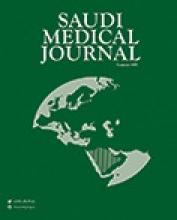Abstract
OBJECTIVE: Evaluation of known predictors of gangrene in neonates with necrotizing enterocolitis (NEC) and identification of those suggestive of severe disease, requiring expeditious laparotomy rather than primary peritoneal drainage as a definitive treatment.
METHODS: This is a retrospective review of data collected from the medical records of newborns with confirmed NEC, treated at the Maternity and Children's Hospital, Dammam, Kingdom of Saudi Arabia, from May 1993 to May 2004. Fifty-five cases were selected for the study, 23 had successful medical management and 32 underwent laparotomy. Of this group, 15 had peritoneal drainage prior to laparotomy. Nine known clinical, radiological and laboratory features suspicious of bowel perforation or gangrene were evaluated. The operated group was classified according to the extent of disease into isolated, multifocal or pan intestinal and the distribution of these 9 criteria was calculated for each of the 3 groups. Comparison was then carried out between the group with isolated NEC and those with extensive disease.
RESULTS: Isolated NEC was present in 8 (25%), multifocal NEC in 19 (59%) and pan intestinal NEC in 5 (16%) of the operated cases. Pneumoperitoneum and palpable abdominal mass were the most specific and predictive signs of perforated or gangrenous bowel in NEC. Severe pneumatosis intestinalis and gasless abdomen were also highly specific and predictive of the same but had a low prevalence. Abdominal wall erythema, persistent metabolic acidosis, portal vein air, gasless abdomen and severe pneumatosis intestinalis were found to be associated with severe or extensive gangrene. Palpable abdominal mass and fixed dilated loops were increased in cases of isolated NEC. Portal vein air was associated with the highest mortality.
CONCLUSION: Pneumoperitoneum, though the only absolute evidence of bowel perforation, cannot predict the extent of disease. Peritoneal drainage is a useful stabilizing procedure but the presence of any of the above mentioned criteria which are associated with severe disease necessitate a quick decision in favor of laparotomy. The absence of these signs, however, cannot rule out extensive or progressive NEC and failure to improve after peritoneal drainage also requires an emergency laparotomy, regardless of birth weight or gestational age.
- Copyright: © Saudi Medical Journal
This is an open-access article distributed under the terms of the Creative Commons Attribution-Noncommercial-Share Alike 3.0 Unported, which permits unrestricted use, distribution, and reproduction in any medium, provided the original work is properly cited.






